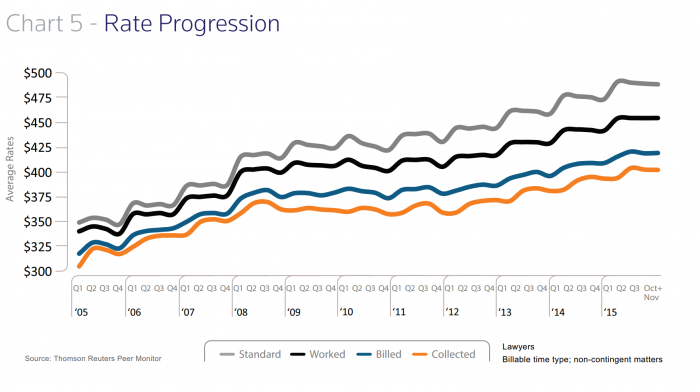- “New entry” is not even a “threat;” it’s a current and growing reality.
- “Supplier power” (that would be talented partners) has never been greater, nor the competition for them greater; and law firms will never have a “substitute” supplier.
- “Buyer power?” What more needs be said?
- As with new entry, “substitution” is not even a “threat” these days: From Axiom to in-house departments to Practical Law to simply doing without, clients have more options than ever before.
- Finally, “competitive rivalry” has rarely before been so powerful. With globalization, firms from all over the place can invade your market (with or without bricks and mortar), tasty boutiques spin out of BigLaw all the time, and the war for talent means today’s satisfied incumbent can find its oxygen cut off without warning. Another word about “competitive rivalry” before moving on. I have heard evidently sober-minded and indisputably senior law firm leaders pronounce, with a frequency both shocking and dumbfounding, that their firm “has no competition.” That can only be true in the rarest of cases where no other law firm can do what yours does. If other firms provide comparable services—or assorted mixtures of quality, price, and service such that, on the whole, clients are indifferent between your firm’s offering and other firms’, then I have bad news for you: You do have competition.
Maister’s analysis of profitability levers may make for even more depressing viewing for those sitting in the BigLaw seats.
In this formula, the key variables and where the dials for them are pointing on most of our dashboards, are as follows:
- Leverage: the number of fee-earners for each equity partner. In many firms, this needle is pinned at or near the max, particularly as the ranks of non-equity partners have exploded in the past decade or so (to the point where they outnumber associates at a surprising number of firms) and particularly in a world where discerning clients increasingly prefer and demand the hands-on attention of the senior-most equity partner in lieu of ranks of juniors.
- Utilization: How many hours a year can a human being bill? Does demand support keeping every one busy all year long, working flat-out? The answers are: (a) there’s a humane limit; and (b) at the vast majority of firms, no.
- Blended billing rate: How high can rates really go? And what are the consequences for realization with every new rate hike? On this note, many firms stoutly maintain that although their realization keeps sliding year over year, their rate increases more than make up for it. We decided to test that assertion using Thomson Reuters PeerMonitor data (as published in Georgetown’s 2016 “State of the US Legal Market“) and adjusting the ten-year data series for inflation, while standard “rack” rates have indeed gone up in constant dollars, ultimate collections have lost ground. In other words, on average across all the firms in the PeerMonitor database the happy-talk assertion that rate hikes have more than made up for erosion in realization is false. If some firms are indeed doing better, than it’s an arithmetic tautology that others are doing worse.
- Total expenses: The biggest components of law firm expense are compensation and benefits, occupancy, and then a host of miscellaneous factors such as professional insurance, marketing, and IT, which aren’t substantial enough to move the needle. For the big two (comp and office space), how much more juice can be squeezed from the lemon? Comp for lawyers and staff is pretty much set by the competitive market and staff-to-lawyer ratios are at all-time lows. As for your gorgeous offices? You cannot, realistically, move to the warehouse district in town; it’s Class A space for you, pal.
Here’s the PeerMonitor data series I referred to:
Remaking Law Firms proceeds to discuss and analyze the increasing sophistication and discernment of clients (and yes, they talk about the dreaded “procurement” department), before moving on to what the authors call “the 2025 kaleidoscope scenario.” I take that to mean that by 2025 in their view the sources of supply for legal services—of which law firms are a subset only—will be multifaceted and include a heterogeneous array of companies and providers.
The remainder of the book surveys and provides concrete guidance on:
- assessing how prepared for change your firm is (including a diagnostic tool)
- ways to design or re-design your firm’s business model
- brand, marketing, and business development, premised on client relationships and service
- pricing and fee arrangements
- sources of supply for law firms and outsourcing
- legal project management and its slightly newer cousin, process improvement (which, they suggest, must be combined for optimal results, but which is also no small task)
- technology, KM, and analytics
- and finally the all-important and over-arching impact that partners’ hands on the tiller of management exerts. Here the language is along the lines of “negative emotions,” “the change monster,” the “quest for perfection” which is at odds with the market’s demand for a variety of experiments.
All in all, Remaking delivers thoroughly, solidly, and comprehensively on its promise of providing a roadmap to the why and how of the way ahead for law firms that believe the forces of change outlined in the beginning are real and are going to gain force. You could say that the title, combined with George’s sterling background and credentials, deliver what’s promised in spades.
Truth in advertising, after all!





